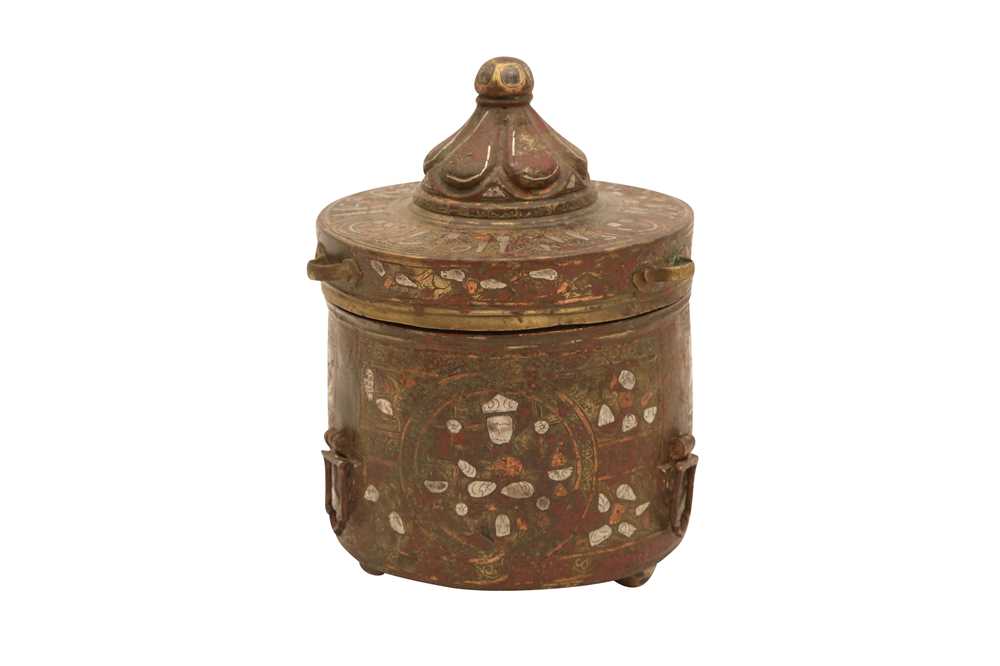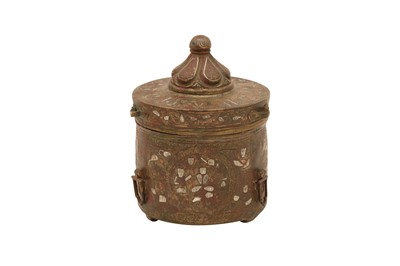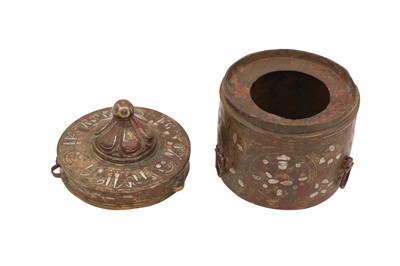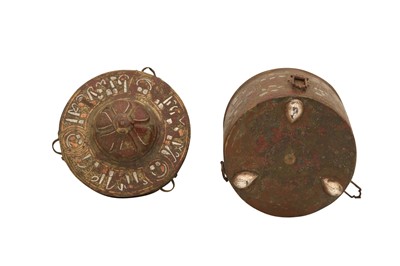28th Oct, 2022 11:00
Islamic Art - Property of a European Collector Part IV
A LARGE SELJUK SILVER AND COPPER-INLAID BRONZE INKWELL
Khurasan, Eastern Iran or Herat, 12th - 13th century
A LARGE SELJUK SILVER AND COPPER-INLAID BRONZE INKWELL
Khurasan, Eastern Iran or Herat, 12th - 13th century
Of cylindrical shape, resting on three silvered drop-shaped feet protruding from a heavily engraved base with concentric circles decorated with feline predators and their preys against scrolling vines, the body with three arched hinges, surmounted by a cylindrical lid with a lobed dome-like boss rising to a knob in the centre and three hinged loop handles on the sides in correspondence of the hinges on the body, the lid and body a tour de force celebrating the skilled craftsmanship of Eastern Iranian metalwork, fully engraved and clad in silver and copper inlay, the decoration on the body consisting of three large figural roundels with courtly subjects, possibly rulers or princes as allegories of planets, celebrating and banqueting surrounded by assistants and animals; in the negative spaces around the corners animal and figural symbols illustrating the traditional Twelve Zodiac signs accompanied by inscriptions in Arabic pseudo-thuluth and plain naskh scripts identifying them, all framed within narrow bands of vegetal scrollwork; the lid decorated with a band of running animals around the rim; animated Kufic script on the outer edge of the top; miniaturised auspicious blessings in Persian naskh script around the base of the boss; and further vegetal and figural motifs on the finial, three inscriptions from the maker in pseudo-floriated Kufic script on the outer edge of the lid reading Amal-e al-Naqqash al-Khademin Amal-e Zaki (or Raki, from Raqqa?) Bani (?) [the work of the courtly painter, Zaki Bani or Raki Bani], the interior of the lid engraved with further vegetal scrollwork, and the inner drip-tray of the inkwell featuring a band of floriated Kufic script, 10cm diam. and 15cm high.
In Islam, the special role of the written word is emphasised in a number of pivotal religious texts like the Qur'an and the hadiths. Since the early stages of the Islamic civilisation, the importance embodied by the act of writing was extended to writing implements and tools like inkwells and pen cases, without which the consolidation of texts and the spread of written knowledge would have not been possible. This trend is particularly prominent in the Seljuk period, when important madrasas were established, leading to the production of some of the most relevant religious, scientific and literary works of the Medieval time (Deniz Beyazit in Court and Cosmos: The Great Age of the Seljuqs, 2016, p. 273).
Despite the religious proscription of using precious metals on personal ornaments and utilitarian objects, Seljuk inkwells often showcase elaborate embellishments and designs overlaid in silver and copper, adding a charming polychrome effect to their dark-coloured copper alloy bodies. Scholars have already pointed out the high degree of similarity in the artistic vocabulary between these fine metalwork creations and Seljuk mina'i ceramics produced around the 11th and 12th centuries, showing a uniform cultural substratum of visual content. Together with benedictory Arabic inscriptions, animal motifs, and scenes from a carefree courtly life, the Twelve Zodiac signs feature as a prominent decorative motif embellishing Seljuk bronze writing implements. The depiction of the Zodiac, often incorporated into courtly scenes, relied on the medieval belief that the presence of such imagery on these vessels could invest them with cosmological and talismanic properties, placing their owners under the auspicious influence of the stars (Francesca Leoni in Masterpieces from the Department of Islamic Art in The Metropolitan Museum of Art, 2011, p. 131).
The large size, detailed and complex decorative program, and conspicuous quantity of precious overlaid metals link the present lot to a royal commission. This hypothesis is further corroborated by the official title of the artist (al-Naqqash al-Khademin), suggesting he was working at a royal atelier or on royal commissions. For an analogous, though smaller, Seljuk silver and copper-inlaid bronze inkwell featuring both the Zodiac sign and Kufic inscriptions on the inner drip-tray, please see the David Collection in Copenhagen (Inv. no. 6/1972). Further examples for comparison can be seen in the Khalili Collection of Islamic Art (no. MTW 1266) and in The Metropolitan Museum of Art (no. 1959 59.69.2a,b, also illustrated Ibidem, cat. 86, p. 131).
Sold for £5,250
Includes Buyer's Premium
Do you have an item similar to the item above? If so please click the link below to submit a free online valuation request through our website.




